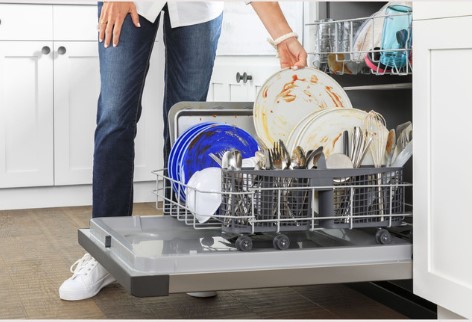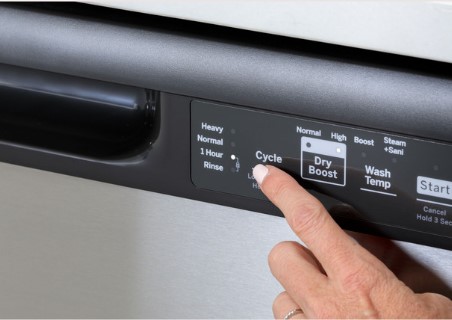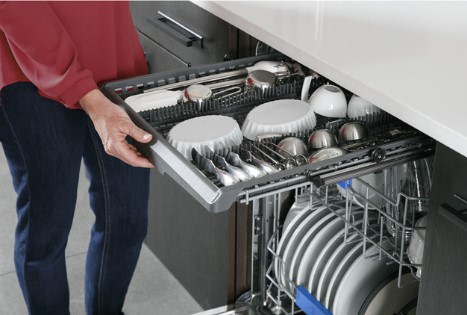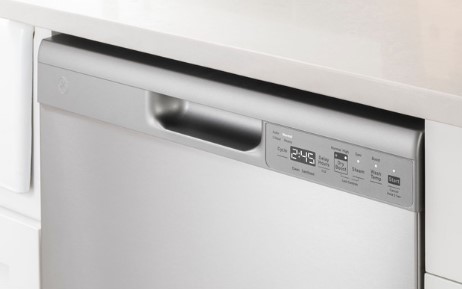A GE dishwasher’s cleaning and dish-drying performance is undeniable, but that doesn’t make them issue-proof. These dishwashers can fail, and when they do, you should be able to perform the necessary GE dishwasher troubleshooting, and that’s where this guide comes in.
Common GE dishwasher problems include (the dishwasher) not starting, not cleaning, not draining, not filling with water, and not drying. Others are the dishwasher leaking, blinking, or beeping (without starting), non-responsive buttons, the door not opening or closing, and a burning smell.
These 12 issues are among the commonest and easiest to fix once you know what to check. So, I’ll discuss their most probable causes and applicable fixes so you can troubleshoot them DIY.
The goal is to fix the issue as quickly as possible DIY and save on the expensive costs of hiring a dishwasher expert. Remember, doing the troubleshooting also equips you with the necessary maintenance knowledge to prevent some of the issues.
Without further ado, let’s jump into the 12 issues.

In a hurry? Consider the table below highlighting the likely causes and applicable fixes of the 12 common GE dishwasher issues.
Quick GE Dishwasher Troubleshooting Guide
| Problem | Likely Cause | Applicable Fix | |
| 1. | GE Dishwasher Won’t Start | Lack of power, setting issue (active Delay Start, Control Lock, or Demo Mode), unlatched door, or leak detection | Check the dishwasher’s power supply, deactivate Delay Start, Control Lock, or Demo Mode, latch the door properly, and call for service in case of a leak detection |
| 2. | GE Dishwasher Won’t Clean | Wrong cycle, wrong water temperature (below 1200F), low-quality Rinse-Aid, wrong detergent, improper dish-loading, or clogged drain filter, spray arms, or dishwasher interior. | Choose the right cycle setting and cycle temperature (above 1200F), use quality Rinse-Aid and recommended detergent, load the dishes properly, and clean the drain filter, spray arms, and dishwasher interior to get rid of food clogs |
| 3. | The GE Dishwasher Won’t Drain | Clogged drain filter, air gap, or garbage disposer, wrong or excessive dishwashing detergent, low-quality Rinse-Aid, or incorrect installation | Unclog the drain filter, air gap, and garbage disposer, use the correct detergent (and the correct amount) and recommended Rinse-Aid, and call an expert in case of a wrong installation |
| 4. | GE Dishwasher Won’t Fill with Water | Water supply fault, defective flood float, and bad drainage | Ensure the dishwasher has water, replace a damaged/stuck flood float, and check the drainage to ensure the water drains properly |
| 5. | Leaky GE Dishwasher | Worn-out door gasket, loose hose or hose clamp, or a defective pump, float switch, or water inlet valve | Replace a worn-out door gasket or defective pump, float switch, or inlet valve, and fix a loose hose or clamp |
| 6. | GE Dishwasher Blinks But Won’t Start | A resetting dishwasher or an issue like a power surge, a defective inlet valve, or a burnt heating element | Give the dishwasher time to complete the reset. If the blinking doesn’t stop, reset the dishwasher and replace a defective inlet valve or heating element |
| 7. | GE Dishwasher Beeps But Won’t Start | An unlatched door, error code, power surge, or a defective control board | Properly latch the door, reset the dishwasher in case of an error code or power surge, and replace a faulty control board |
| 8. | Non-Responsive GE Dishwasher Buttons | Lack of power, error code, unlatched door, or a defective touchpad, control panel, or main control board | Ensure the dishwasher has power, reset it to clear an error code, properly latch the door, and replace a defective control panel or main control board |
| 9. | GE Dishwasher Won’t Dry Dishes | The wrong setting, faulty turbidity sensor, blocked vent, or burnt heating element | Select Heated-Dry, replace a faulty turbidity sensor, unblock the dishwasher vent, and replace a burnt heating element |
| 10. | GE Dishwasher Door Won’t Open | Defective door latch | Call service |
| 11. | The GE Dishwasher Door Won’t Latch | Blocked door path, broken door latch, or damaged door hinge or door cable | Clear any obstruction and replace a broken door latch or damaged door hinge, or door cable |
| 12. | Burning Smell | Hot packing material or plastic or shorted drain valve, heating element, timer, or control board | Remove the packing material and plastic inside the dishwasher and call for service in case of a shorted drain valve, heating element, timer, or control board |
12 Common GE Dishwasher Problems
Below are 12 issues common among GE dishwashers:
1. GE Dishwasher Not Starting (GE Dishwasher Not Working)
Your GE dishwasher won’t work if it doesn’t start. So, it’s fair to say that a non-starting dishwasher is a non-working dishwasher.
Sometimes, the dishwasher won’t work because of the lack of power, while in others, the appliance fails to start despite having power.
Let’s look at the two scenarios.
GE Dishwasher Not Starting No Power (Won’t Turn On)
If your GE dishwasher won’t turn on, it’s likely because of a power issue. In such a case, watch out for any of these issues:
- Possible blackout
- Tripped breaker – in case of a power surge
- Loose or damaged power cable
- Unturned power switch
- Defective power socket
Fix
Is there a power blackout? If there’s, that’s the issue – so wait for the power restoration. Reset the breaker if it’s tripped, and ensure you firmly plug in the power cable and turn on the dishwasher.
Meanwhile, test the power cable and power socket with a multimeter. If they lack continuity, that shows they are defective, and so replace them.

GE Dishwasher Not Working But Has Power
If your GE dishwasher has power but will not start, the chances are that it’s due to one of these issues:
- Setting issue (active Delay Start, Control Lock, or Demo Mode) – If Delay Start, Control Lock, or Demo Mode is active, they’ll prevent the dishwasher from starting. So, check them.
- Unlatched door –The dishwasher won’t run if the door is open, even slightly. It could be that something blocks it or the door latch is broken.
- Leak detection – The leak detection feature is present on some GE dishwashers (with LCD) to tell you when a leak is detected. In such a case, the feature stops the dishwasher from running.
Fix
Disable the Delay Start, Control Lock, or Demo Mode if any of those settings are active, and correctly latch the dishwasher door. If the dishwasher door won’t shut and nothing obstructs it, inspect the door latch for signs of damage and replace it if that’s the case.
Meanwhile, call a service technician to check for the source of the leak in case the leak detection warning or light pops up on the LCD.
2. GE Dishwasher Troubleshooting Not Cleaning
Sometimes the GE dishwasher won’t wash well, thus leaving the dishes somehow dirty. At other times, however, the dishwasher may fail to clean at all. In such a case, the cause could be any of these:
- Wrong cycle – The dishwasher will fail to clean if you pick the incorrect wash cycle. Thus, it’s good to familiarize yourself with the manual so that you can know how to use the various wash cycles.
- Wrong water temperature – If the dishwashing water temperature is below 1200F, the dishwasher won’t clean.
- Low-quality Rinse-Aid – Ideally, GE recommends Finish Jet Dry and Cascade Platinum Power Rinse-Aid for the best cleaning and spot-free performance. If you use a low-quality Rinse-Aid, the dishwasher may fail to clean the dishes.
- Wrong detergent – If you use unsuitable detergent, the dishwasher may fail to clean the dishes.
- Improper dish-loading – The dishes shouldn’t be in each other’s way. The dishwasher won’t clean the dishes if they are, perhaps blocking the door from shutting correctly.
- Clogged drain filter, spray arms, or dishwasher interior – Food may clog the drain filter and spray arms, and once that’s the case, the dishwasher may fail to clean. Additionally, if the dishwasher’s interior is greasy or grimy, the dishes will come out messy.
Fix
Choose the correct dishwashing cycle. Check your GE dishwasher troubleshooting manual for directions. If the dishwashing water temperature is below 1200F, adjust it to at least that range.
Meanwhile, ensure you use the Rinse-Aid that the dishwasher manufacturer recommends, preferably Finish Jet Dry or Cascade Platinum Power Rinse-Aid, and the recommended detergent.
If not, load the dishes properly and clean the drain filter, spray arms, and dishwasher interior if they are food-clogged or filthy.
3. GE Dishwasher Troubleshooting Not Draining
Good drainage is essential for the optimal cleaning performance of a dishwasher. Sadly, some issues stop the GE dishwasher from draining properly, and they include the following:
- Clogged drain filter, air gap, or garbage disposer – If the drain filter, air gap, or garbage disposer is blocked, the dishwasher won’t drain, which may affect its filling ability.
- Wrong or excessive dishwashing detergent – If the detergent amount is too much or you use the wrong detergent type, it could form too much foam(suds), which may end up stopping the dishwasher from draining properly.
- Low-quality Rinse-Aid – The Rinse-Aid may also stop the dishwasher from correctly draining if it’s low-quality. That’s why you should go with the Rinse-Aid that the manufacturer recommends.
- Wrong installation – Sometimes, the issue could be an incorrect installation. There could be a blockade in the drain pipe, which is why your dishwasher won’t drain.
Fix
Clean the drain filter, air gap, and garbage disposer if they are food-clogged, and ensure you use the wrong or excessive dishwashing detergent.
In the case of the Rinse-Aid, use Finish Jet-Dry or Cascade Platinum Power Rinse-Aid, and if you suspect a wrong installation, call a dishwasher expert.
4. GE Dishwasher Not Filling with Water – Troubleshooting
You expect your GE dishwasher to fill up with water before it can start washing. That, however, won’t happen due to these reasons:
- Water supply fault – If the water doesn’t get to the dishwasher, perhaps due to a kinked supply tube or failure to turn on the supply valve, the dishwasher won’t fill.
- Defective flood float – If the flood float is stuck or broken, it’ll prevent the dishwasher from filling up.
- Bad drainage – If the water doesn’t drain properly, your dishwasher will stop filling up. Revisit the issues discussed earlier to see if your dishwasher has a drainage problem.
Fix
Check if the supply valve is open and unkink the water supply tube if it has some kinks. Replace the flood float if it’s defective, and check out the fixes shared earlier if your dishwasher won’t drain properly.
5. GE Dishwasher Leaking
A leaky GE dishwasher points to a severe problem. And so, you should check the dishwasher to determine why it’s leaking.
Some of the triggers to watch out for include the following:
- Worn-out door gasket – If the door gasket is worn out, the door won’t shut airtight, which means water will leak out.
- Loose hose or hose clamp – Water will also leak out if the supply hose or the clamp is loose. Thus, inspect them too.
- Defective pump, float switch, or water inlet valve – The dishwasher will leak if the pump, float switch, or water inlet valve is faulty.
Fix
Replace a worn-out door gasket and fix the supply hose and hose clamp if they are loose. Check the pump, float switch, and water inlet valve. If they are faulty, replace them. A dishwasher expert can help you here.

6. GE Dishwasher Blinking But Not Starting
If your dishwasher is blinking but won’t start, there is a chance that it’s on reset. You could have reset it unknowingly. However, if the blinking doesn’t stop, the issue could be any of these:
- Power surge – It could be that there has been a power surge, and the dishwasher is blinking to alert you of that. In such a case, the blinking is an error code.
- Defective inlet valve – If the water inlet valve is faulty (which you can tell if it won’t pass the multimeter electrical continuity check), the dishwasher will blink and fail to start.
- Burnt heating element – Sometimes, the dishwasher blinks and fails to start because of a burnt heating element. You can also check it with a multimeter.
Fix
If the dishwasher is on reset mode, give it time to reset. If not, reset it to fix any power surge or error code issue. Meanwhile, consider replacing the water inlet valve or heating element if they lack continuity.
7. GE Dishwasher Not Working Keeps Beeping
Consider these issues if your GE dishwasher beeps but won’t start:
- An unlatched door – The door could be open, and if so, the dishwasher won’t start and will therefore beep
- Error code – Sometimes, the dishwasher beeps to indicate an error code that stops it from starting
- Power surge – A power surge may also cause the GE dishwasher to beep and prevent it from starting
- Defective control board – At times, the reason for the beeping is a faulty main control board, and once that’s the case, the dishwasher won’t start.
Fix
Properly latch the dishwasher door. More fixes are discussed below under a door that won’t shut. Reset the dishwasher to fix an error code or power surge. Check out on GE website for extra tips on GE dishwasher troubleshooting codes.
And if the beeping still doesn’t stop, replace the main control board.
8. GE Dishwasher Buttons Not Working
Sometimes the dishwasher buttons won’t respond when you touch them. That could happen due to any of these reasons:
- Lack of power
- Error code
- Unlatched door
- Non-working control panel, touchpad, or main control board
Fix
First, check if your dishwasher has power. If it doesn’t, use the tips shared earlier to find out why and fix it. Meantime, reset the dishwasher to clear an error code and try to latch the door firmly.
If some of the buttons are responsive, replace the touchpad first, and if that doesn’t work, replace the control panel. However, if all the buttons aren’t working and your dishwasher has power, replace the main control board.
9. GE Dishwasher Not Drying Dishes
The dishwasher’s job is not just to clean the dishes but also to dry them. That, however, may not happen sometimes, and it could be due to these issues:
- A possibly wrong setting – for example, failing to select Heated-Dry
- Faulty turbidity sensor – The turbidity sensor’s job is to determine how long the wash and rinse cycles are, and if it’s defective, the dishes will come out wet.
- Blocked vent – If the dishwasher vent doesn’t open fully, it’ll interfere with hot air circulation, stopping the dishes from drying properly.
- Burnt heating element – The heating element’s work is to heat the dishwasher, so the dishes won’t dry if it burns out.
Fix
Choose the correct setting, such as Heated-Dry, and replace a defective turbidity sensor. Try to unblock the dishwasher vent and replace the heating element if it fails the multimeter electrical continuity check.
10. GE Dishwasher Door Not Opening
If the dishwasher door won’t open, it’s more likely due to a defective door latch.
Fix
Consider calling a dishwasher expert.

11. GE Dishwasher Door Not Latching
The dishwasher door may also fail to close. If so, the cause could be any of these:
- Blocked door path – something could be standing on the door’s path
- Broken door latch
- Damaged door hinge or door cable
Fix
Ensure nothing obstructs the dishwasher door from closing firmly, and replace a broken door latch, door hinge, or door cable.
12. GE Dishwasher Smelling Like Burning
Lastly, your GE dishwasher might smell like burning, showing a serious issue. The cause could be any of these:
- Hot packing material or plastic – The packing material or plastic inside the dishwasher could be burning and thus producing the burning smell
- Shorted drain valve, heating element, timer, or control board – If the drain valve, heating element, or control board is short-circuited, the dishwasher will smell like burning
Fix
Remove any burnt plastic or packing materials and call an expert to fix any short-circuiting issue.
Closing Thought:
Above is a simple-to-execute GE dishwasher troubleshooting guide. Use it on the discussed 12 problems. As shared, the issues are not too intricate to fix, and most are DIY. So, give the guide and try and save yourself money and time!
Also Read:
